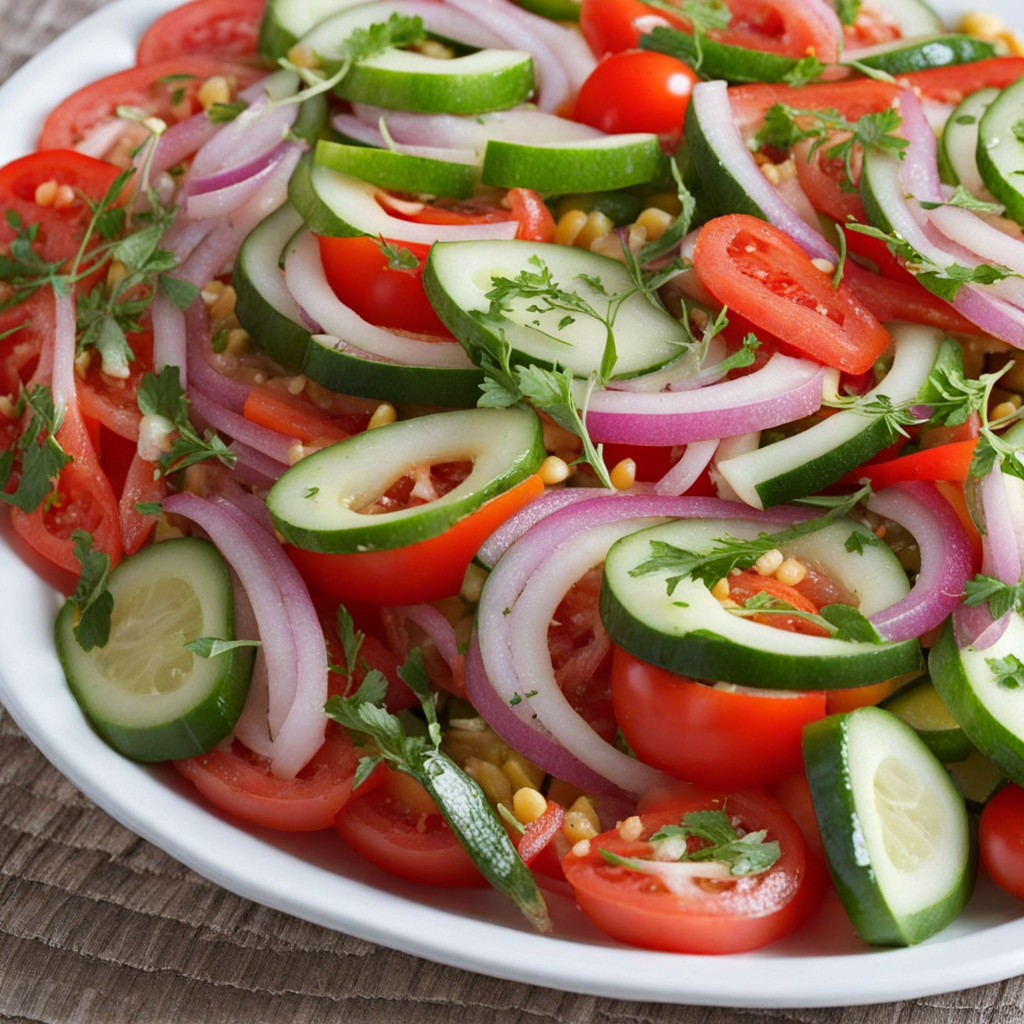Shakshouka
Shakshouka is a vibrant and aromatic dish that hails from the rich culinary traditions of Tunisia. At its core, Shakshouka features poached eggs nestled in a spicy, savory sauce made primarily from ripe tomatoes, bell peppers, and onions. The dish is often seasoned with a medley of spices, including cumin, paprika, and cayenne pepper, which lend a warm and robust flavor profile. The combination of these ingredients creates a hearty and comforting meal that can be enjoyed any time of day, though it is particularly popular for breakfast or brunch. The base of Shakshouka is typically simmered until the tomatoes break down into a thick, luscious sauce, creating a perfect environment for the eggs to cook gently. As the eggs poach in the bubbling sauce, their whites become tender while the yolks remain runny, ready to be broken and mixed into the rich, spicy goodness. The dish is often garnished with fresh herbs like parsley or cilantro, adding a touch of freshness and color to the presentation. A sprinkle of feta cheese can also be added for a creamy contrast, enhancing its flavor and texture. Served directly from the pan, Shakshouka is best enjoyed with crusty bread or pita, perfect for scooping up the delicious sauce and eggs. Each bite offers a burst of flavors, making it a delightful experience for the palate. This beloved dish not only showcases the bold flavors of Tunisian cuisine but also reflects the warmth and hospitality of the culture, inviting diners to gather around the table and savor every moment.
How It Became This Dish
## The Rich Tapestry of Shakshuka: A Culinary Journey from Tunisia Origins and Etymology Shakshuka, a dish that has captured hearts and palates across the globe, traces its origins to Tunisia. The term "shakshuka" comes from the Arabic word "شَكَشُوكَة," which means "a mixture" or "to mix." This etymology reflects the dish’s foundational characteristic: a harmonious blend of ingredients, primarily eggs and a spiced tomato sauce. While its precise beginnings can be somewhat nebulous, it is widely believed that shakshuka emerged from the Maghreb region of North Africa, with Tunisia being one of its most significant birthplaces. Historically, Tunisia has been a melting pot of cultures, influenced by Berber, Arab, Turkish, French, and Italian traditions. This rich tapestry is reflected in its cuisine, with shakshuka embodying the essence of Tunisian cooking—simple yet flavorful, communal yet individual. Ingredients and Preparation Though the basic components of shakshuka are relatively simple, the preparation is where creativity takes flight. Traditionally, shakshuka is made with ripe tomatoes, onions, garlic, and peppers, seasoned with spices such as cumin, paprika, and harissa, a spicy paste made from chili peppers. The final touch involves cracking fresh eggs into the simmering sauce, allowing them to poach gently until the whites are set while the yolks remain runny. Each ingredient serves a purpose, creating a dish that resonates with Tunisian agricultural practices. Tomatoes and peppers thrive in Tunisia’s Mediterranean climate, while eggs symbolize sustenance and fertility. The use of harissa not only adds heat but also reflects Tunisia’s penchant for bold flavors. Cultural Significance Shakshuka is more than just a dish; it is a cultural artifact that embodies the spirit of Tunisian hospitality and communal dining. Often served in a communal skillet, shakshuka invites sharing and interaction, making it a staple during family gatherings and social occasions. The dish is commonly enjoyed for breakfast or brunch but can be a hearty meal at any time of day. In Tunisia, it is customary to eat shakshuka with bread, which is used to scoop up the rich sauce and eggs. This practice highlights the dish's role in fostering community, as dining becomes an interactive experience rather than a solitary one. The communal nature of shakshuka mirrors the importance of family and friendship in Tunisian culture. Shakshuka Across Borders As with many traditional dishes, shakshuka has traveled beyond its borders, adapting and evolving in various cultures. When Jews migrated from North Africa to Israel in the 1950s, they brought shakshuka with them, where it quickly became a beloved breakfast dish. In Israel, shakshuka has gained a reputation as a quintessential part of the local cuisine, often garnished with feta cheese, fresh herbs, and served with a side of pita. The journey of shakshuka reflects the broader patterns of migration and cultural exchange, demonstrating how food can transcend geographic and political boundaries. Its popularity in Israel has led to a myriad of interpretations and variations, showcasing the versatility of the dish. From spicy versions laden with chili to milder takes featuring sweet peppers, each rendition tells a story of adaptation and innovation. Modern Variations and Global Influence In recent years, shakshuka has gained international acclaim, appearing on menus in trendy cafes and restaurants around the world. Chefs have embraced its adaptability, experimenting with ingredients like chorizo, spinach, and even avocado. This evolution showcases the dish's ability to resonate with contemporary palates while maintaining its core essence. Social media has played a significant role in the global proliferation of shakshuka. Platforms like Instagram and Pinterest have allowed home cooks and professional chefs alike to share their unique takes on the dish, often beautifully plated and photographed. This visual appeal has contributed to its status as a trendy breakfast and brunch option, leading to a renaissance of interest in Tunisian cuisine and North African flavors. The Nutritional Benefits Beyond its delicious taste and cultural significance, shakshuka is also a nutritious dish. Packed with vitamins from the vegetables and protein from the eggs, it provides a balanced meal that is both satisfying and healthful. The use of olive oil in the sauce not only adds flavor but also contributes healthy fats, aligning with the Mediterranean diet known for its numerous health benefits. This nutritional aspect has further propelled shakshuka into the spotlight, as consumers become increasingly conscious of the healthfulness of their food choices. In a world where convenience often trumps quality, shakshuka stands out as a nourishing, homemade option that can be prepared relatively quickly. Conclusion: A Dish with a Story Shakshuka is more than a simple egg and tomato dish; it is a vibrant expression of Tunisian culture, history, and community. From its humble beginnings in North Africa to its status as a global culinary phenomenon, shakshuka embodies the power of food to connect people across borders and generations. As we savor shakshuka today—whether in a traditional Tunisian household or a modern café in New York—we partake in a shared experience that transcends time and space. Each bite carries with it the stories of the farmers who cultivated the ingredients, the cooks who perfected the recipe, and the families who gathered around the table to enjoy it. In an ever-evolving culinary landscape, shakshuka remains a testament to the enduring legacy of Tunisian cuisine, inviting us to appreciate the flavors of tradition while embracing the innovations of the present. So, the next time you enjoy a plate of shakshuka, remember that you’re not just indulging in a meal; you’re participating in a rich narrative that spans centuries and continents, one delicious bite at a time.
You may like
Discover local flavors from Tunisia







